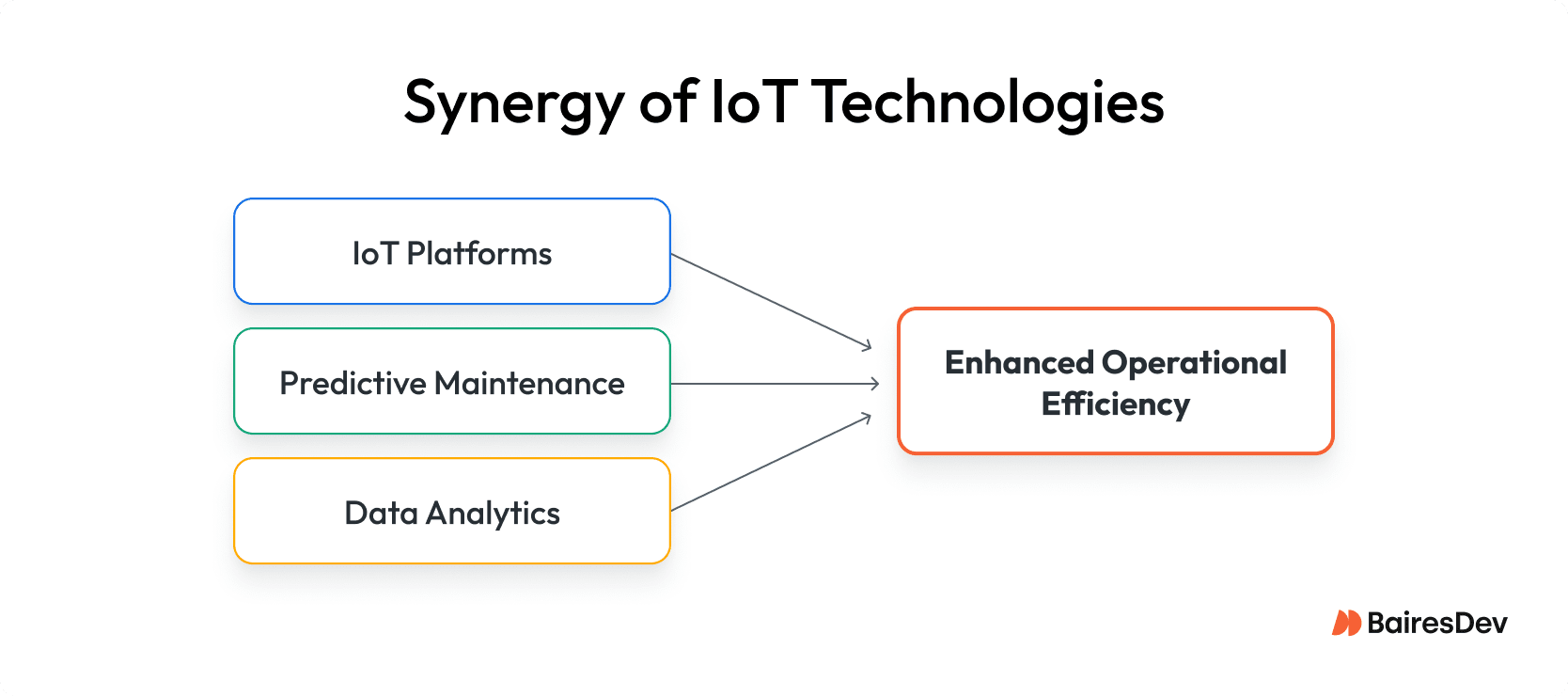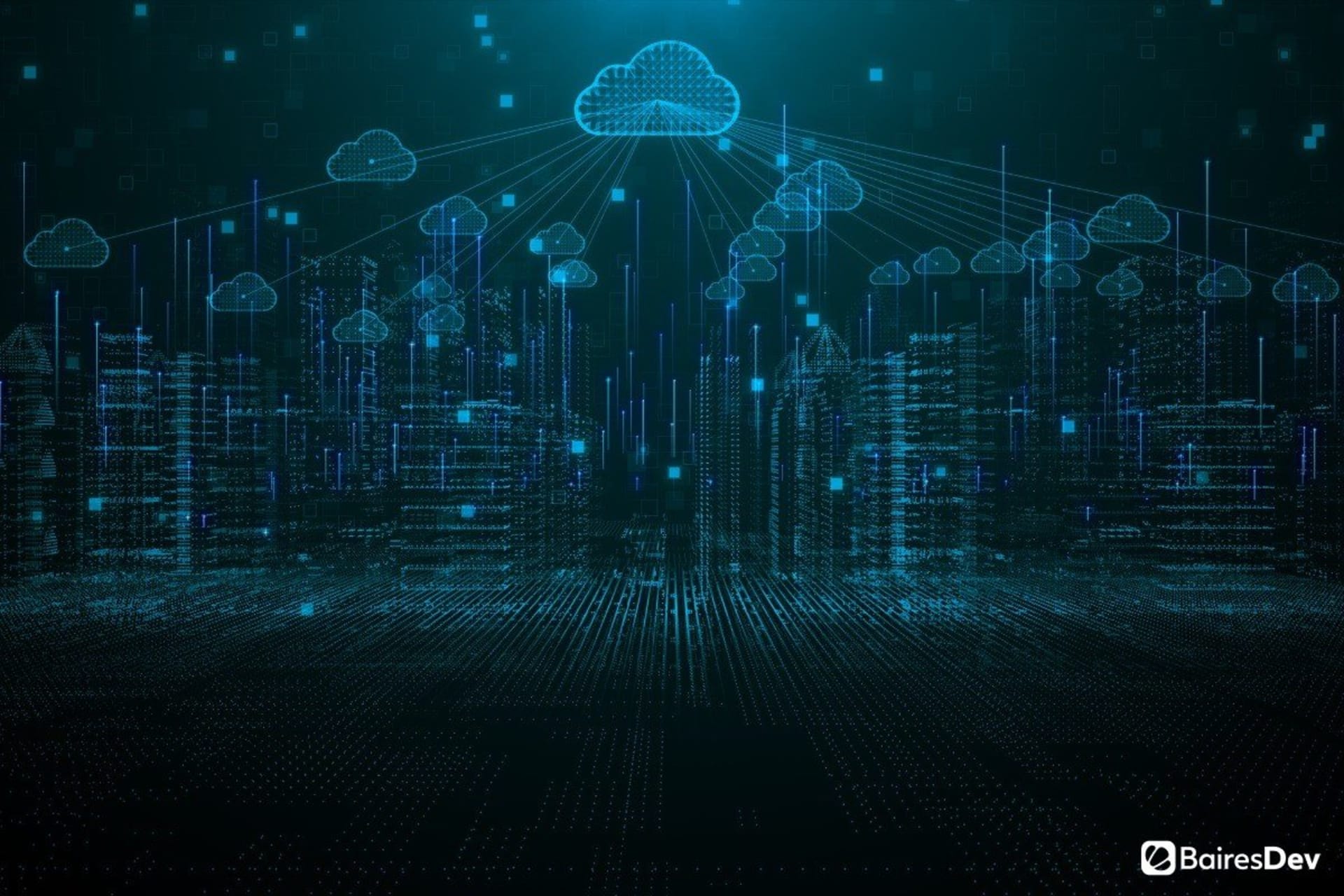The Internet of Things (IoT) has become an integral part of digital transformation. By 2030, the global IoT market is projected to surpass 40 billion connected devices, driving new efficiencies across healthcare, manufacturing, logistics, retail, and smart cities.
What does it mean for leaders, and what action should they take? Let’s review the IoT trends that matter most for enterprises in 2025, with a focus on operational scale, data strategy, compliance, sustainability, and long-term ROI.
What’s Trending in the IoT Sector in 2025?
Consumer adoption of smart devices grabs headlines, but the real transformation is happening inside enterprises.
Manufacturing plants now depend on smart factories where connected IoT devices run production lines and predict failures. Hospitals rely on IoT sensors to monitor patients in real time. This results in faster response times in case of emergencies and generates a lot of useful data.
Logistics companies are scaling real-time tracking across global supply chains to cut waste. Energy firms use IoT networks to monitor grid performance. Retailers apply IoT data to streamline inventory management.
In agriculture, connected sensors monitor soil conditions and weather patterns. Financial services firms deploy IoT-driven monitoring systems for fraud detection. Enterprises are also using IoT to strengthen compliance, tying connected devices to reporting frameworks that meet regulatory requirements across healthcare, finance, and manufacturing.
The pattern is clear: IoT has shifted from small-scale pilots to mission-critical infrastructure.
Optimizing Resources with Digital Twins
A defining IoT trend for 2025 is the use of digital twins. They are virtual replicas of physical assets and processes that update in real time. These models give enterprises a powerful way to monitor operations.
Smart sensors already support practical use cases, such as tracking restroom usage to validate cleaning schedules or monitoring production processes in smart factories to detect inefficiencies.
In supply chain management, digital twins integrated with predictive analytics allow companies to forecast demand more accurately and allocate resources more effectively.
Improved Efficiency and Productivity Through IoT Analytics
The use of IoT analytics helps companies become smarter. Collecting data from connected devices allows them to spot patterns and make better decisions.
Retailers are also benefiting from IoT analytics. Many now use automated stores where customers can shop and check out without staff. Sensors and cameras track items and customer movements. This improves the shopping experience and cuts labor costs.
Machine-to-machine communication is another key feature. Devices talk to each other and share data without human help. This speeds up processes and reduces errors.
IoT analytics also helps companies understand market trends. This leads to better products and services. For example, wearable tech companies use data from fitness trackers to improve health apps.
Expansion with 5G and Cellular Networks
The rollout of 5G and next-generation cellular networks is opening up new opportunities for IoT technology.
Faster data exchange with edge devices reduces latency. Increased device density allows for widespread connectivity across both urban and rural areas. This expanded network capacity also creates room for emerging technologies – for instance, augmented reality integrated with IoT applications in training, healthcare, and field service.
In practice, what this means is that IoT applications that were constrained by bandwidth and infrastructure can now operate at scale.
IoT Security and Device Management Challenges
The risks are wide-ranging, from inconsistent security standards and weak authentication to outdated device management and vulnerable sensors that can open the door to data breaches. Each connected device represents a potential entry point, and as deployments scale to thousands of endpoints, the attack surface multiplies exponentially.
To manage this expanding attack surface, organizations need enterprise-grade IoT solutions that embed security by design. That includes end-to-end encryption, continuous updates, and increasingly, AI-driven threat detection to monitor and respond in real time.
Zero-trust architecture is becoming standard practice, requiring device authentication at every interaction rather than assuming network-level security is sufficient.
Device lifecycle management adds another critical dimension. Organizations must track firmware versions across device fleets, push security patches without disrupting operations, and manage secure decommissioning.
For regulated industries like healthcare and finance, IoT security must align with HIPAA, GDPR, and data sovereignty requirements from the start. Retrofitting compliance is far more expensive than building it in.
Edge Computing Systems Reshaping IoT
Edge computing reduces latency and cost by processing data locally instead of sending everything to the cloud. This is how edge is reshaping IoT across industries:
- Industrial automation gains real-time machine control.
- Smart cities manage traffic, utilities, and safety instantly.
- Enterprises cut bandwidth costs and limit sensitive data exposure.
Edge is not replacing cloud IoT platforms but complementing them, allowing enterprises to balance speed, cost, and compliance.
Data Processing and Management: Key IoT Technologies
The exponential growth of IoT data demands robust data processing and management.

By building strategies around key components of IoT, such as data pipelines, scalable storage, and AI-based analytics, organizations can unlock new efficiencies.
Leading enterprises build on platforms like Apache Kafka for real-time data streaming, Azure IoT Hub or AWS IoT Core for device connectivity, and time-series databases like InfluxDB or TimescaleDB for sensor data storage. These tools form the backbone of scalable IoT architectures.
Artificial Intelligence and IoT: Smarter, Faster, Leaner
The fusion of artificial intelligence (AI) and IoT technology allows for complex tasks automation. Let’s look at some of the examples:
- AI-driven IoT solutions reduce downtime in industrial equipment through predictive maintenance.
- Machine learning algorithms analyze data collected by IoT devices to identify anomalies before failures occur.
- Anomaly detection algorithms identify supply chain disruptions early, enabling proactive responses.
- Generative AI is beginning to power user interfaces for IoT dashboards, enabling intuitive control of smart devices.
- Computer vision models process camera feeds for real-time quality control, catching manufacturing defects invisible to human inspectors.
The competitive advantage comes from speed and accuracy at scale. Where human analysis might take hours or days to spot patterns across thousands of data points, AI-powered IoT systems identify issues in seconds and trigger automated responses.
This shift from reactive to proactive operations is reshaping how organizations manage everything from factory floors to distributed infrastructure.
Green IoT and Environmental Sustainability
As sustainability becomes a boardroom priority, Green IoT is gaining traction.
| IoT Application | Impact on Sustainability |
|---|---|
| Smart devices and IoT sensors | Improve energy efficiency and reduce overall consumption |
| Sustainable data centers | Minimize e-waste and lower carbon footprints |
| IoT-enabled supply chain management | Reduce material waste and improve resource allocation |
The Growing IoT Market and Future Outlook
Analyst reports, including those from Fortune Business Insights, point to the IoT market as one of the fastest-rising areas of technology investment. Growth is being fuelled by companies that adopt devices to streamline operations.
Industrial IoT is already reshaping manufacturing, logistics, and energy systems, while smart cities are using connected devices, augmented reality, and other IoT technologies to improve infrastructure.
The next stage of IoT adoption will normalize remote monitoring at scale and give rise to entirely new business models built around real-time data.






